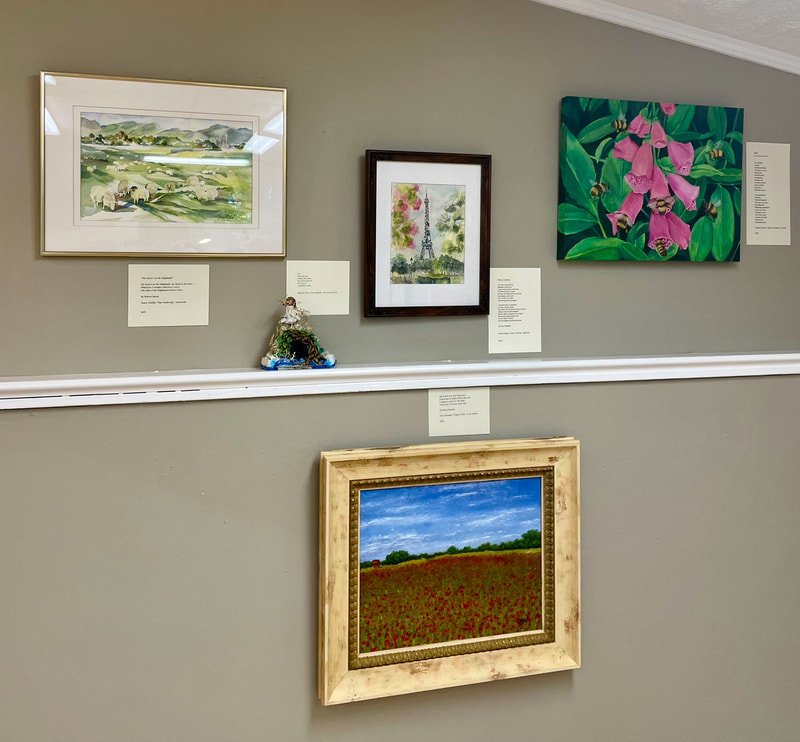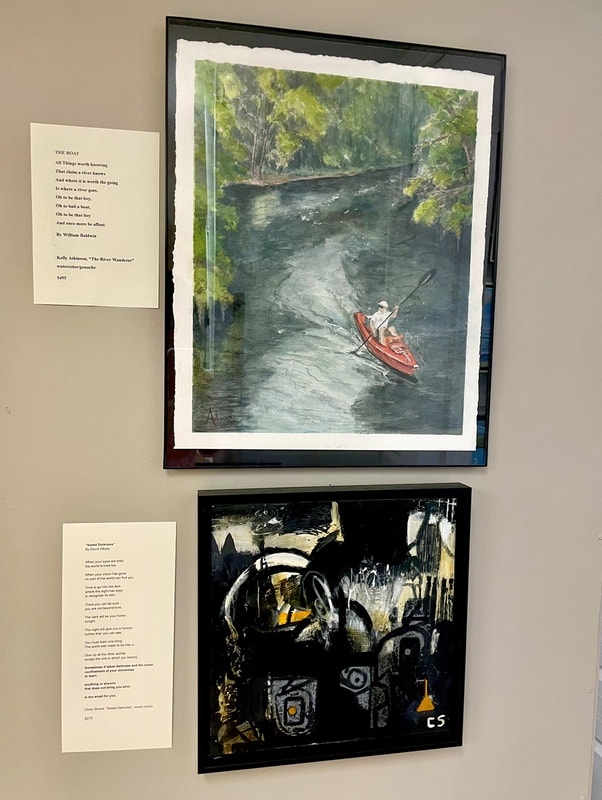
1st place: Kathy LaCasse- "Wonder", mixed media encaustic
Response from Hastings: Kathy LaCasse's "Wonder" captures the delicacy of its subject--a dragonfly--as well as the ephemerality of observation. At its heart is a poetic metaphor--the dragonfly blooms like a flower--which makes the brevity of the moment all the more beautiful amidst a seemingly stormy and swirling backdrop. The painting and the poem both resemble a kind of Japanese haiku, and remind us that art and nature, through the intimacy of a single moment, can restore our sense of wonder.
Response from Maura: "Wonder" is beautifully executed in encaustic paint by this artist's highly skilled yet comfortable hand. The translucent layers of wax add to the luminous quality and wonder of this fleeting yet visually articulated moment in time. The composition of this japanesque arrangement of organic elements is a further nod to the poem's style and poet's voice. All in all a wonderful bonding of painting and poem.
2nd place: Nancy Panfili-"The Gathering", watercolor
Response from Hastings: The short three lines accompanying Nancy Panfili's "The Gathering"--a wistful longing by the Scottish poet Robert Burns--contrast beautifully with the expansiveness of this plein air watercolor. In a style both figurative and abstract, the painting isn’t so much about individual sheep as it is about the gorgeous interplay of light and color. Like the poem, it evokes a memory and the idea of remembering.
Response from Maura: "The Gathering" by Nancy Panfil exemplifies watercolor in its highest and purest form with beautiful shards of transparent colors arranged with experiential knowledge of spatial zones in the landscape. The rolling hills in the painting express visual movement as the poet's words echo this movement in the line "Wherever I wander, wherever I rove,". This landscape is lovingly painted with a skilled hand, a hand that expresses the joy and love of the artist's visual experience while reflecting the poet's literary testament of love for the Highlands.
3rd place: Mikki Huss, "Where Go the Boats", watercolor
Response from Hastings: Mikki Huss's "Where Go the Boats?" incorporates the language of Robert Louis Stevenson's poem in creative, technical, and even whimsical ways. On a purely visual level, the blank space surrounding the text of a poem suggest words unspoken but implied, and this painting, too, suggests life beyond its frame. It captures an image that the casual observer might miss, but one in which the artist finds poetry.
Response from Maura: "Where Go the Boats" is whimsical and mysterious, with a unique and refreshing 'worm's eye' point of view. The harmonious color palette of yellows, greens and blues unifies this composition and reflects colors suggested in the poem by Robert Louis Stevenson. The artist purposely gives us just enough visual information to stimulate the viewer's own imagination as it mirrors the poet's teasing litany of places where his boat might go. Beautifully painted with a strong composition and a wonderful marriage between the painting and poem.















 RSS Feed
RSS Feed